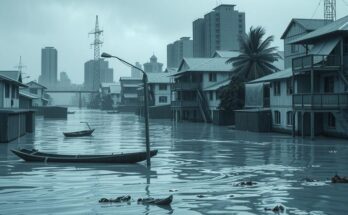A 6.8-magnitude earthquake in Tibet on January 7 resulted in at least 126 deaths and 188 injuries, with many still trapped under rubble. The tremors caused significant structural damage, displacing numerous residents. Rescue efforts are hindered by severe weather and aftershocks, while historical tensions in the region add complexity to the crisis response.
On January 7, a 6.8-magnitude earthquake struck the Tingri district in Tibet, resulting in a tragic death toll of at least 126 individuals and injuries to approximately 188 others. Rescue teams are currently working to recover people trapped under the debris, with reports indicating that an unknown number remain missing. The earthquake also severely affected infrastructure, damaging over 3,600 homes in the region and rendering many individuals homeless.
The tremors extended beyond Tibet, being felt in neighboring areas including Nepal, Bhutan, and India. Rescue operations are further complicated by more than 500 aftershocks and aggressive winter conditions, with temperatures plummeting to -18°C. Eyewitness accounts describe the devastation, noting houses were “shattering” from the quake’s force. In response, the Chinese government has dispatched over 1,800 rescue personnel and 1,600 soldiers to assist in recovery efforts.
The impact of the earthquake not only brings forth immediate humanitarian concerns but also highlights the geopolitical complexities of the region. Tibet, an autonomous region within China, has a tumultuous history regarding its autonomy and cultural identity since the Chinese takeover in 1951. Despite claims from the Chinese government of fostering cultural integration and development, many Tibetans in exile assert that there are systematic efforts to suppress their religious and cultural practices.
The ongoing crisis underscores both the natural disaster’s immediate toll and the historical context that complicates the disaster response. As temperatures continue to drop and the risk of aftershocks remains, effective rescue and recovery initiatives are critical to alleviating the suffering of those affected.
The earthquake that recently struck Tibet is a significant event, given the history of seismic activity in the region, particularly due to its location near the Himalayas. Tibet is an area of geopolitical sensitivity, historically marked by its struggle for autonomy against Chinese governance. Since regaining control over Tibet in 1951, the Chinese government has maintained strict oversight and has faced accusations of suppressing Tibetan culture and Buddhism. These tensions create challenges for local authorities in both recovery efforts and in addressing the broader cultural concerns of the Tibetan people, particularly in the aftermath of natural disasters such as this earthquake.
In summary, the devastating earthquake in Tibet has resulted in substantial loss of life and extensive damage to infrastructure, necessitating urgent humanitarian aid and rescue operations. The incident brings to light not only the immediate crisis of survival but also the historical tensions surrounding Tibetan autonomy and identity under Chinese rule. Moving forward, addressing both the humanitarian needs and the underlying socio-political issues in the region will be essential.
Original Source: babel.ua




